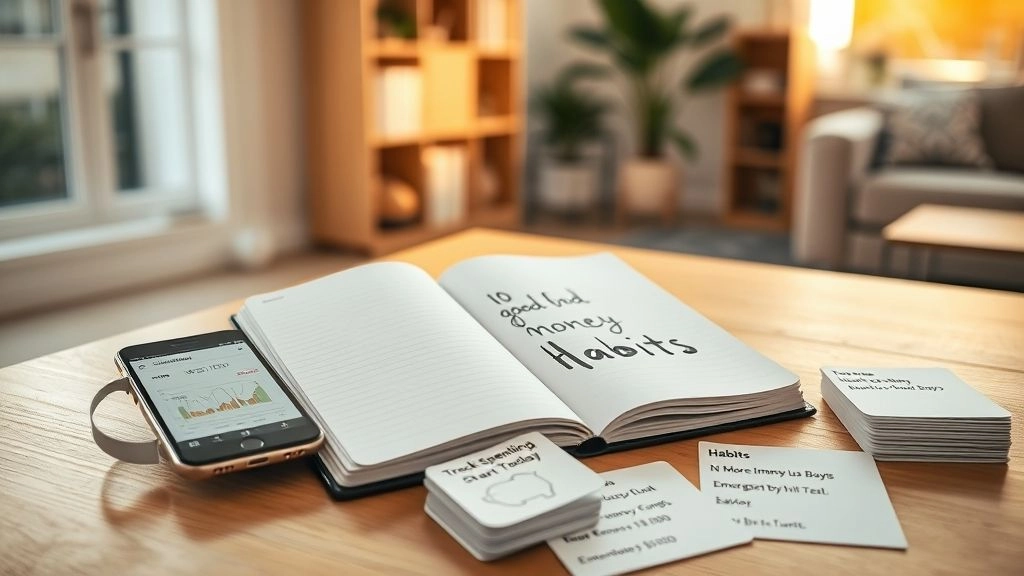Where Does It All Go?
Okay, be honest—have you ever looked at your bank balance and just… blinked? Like, wait, didn’t I just get paid four days ago?! Poof, the money’s gone. Happens to the best of us. A few years back, my Friday pizza nights were basically vacuuming $100 a month from my account. Ridiculous, right?
That’s what got me hooked on learning 10 good money habits. Not boring, lecture-y stuff. Just practical things I could actually manage, even on my busy, caffeine-crazed, “let’s see if instant noodles count as dinner” schedule. Trust me, you can do this too. Maybe you’re a student, a parent, a single dude with a dog, or someone who just wants their wallet to stop crying every Sunday. Let’s chat about the small stuff that adds up in a big way.
Spotting Sneaky Leaks
Am I Actually Spending That Much?
Try this: for one week, write down everything you spend—even that $2 on gum. Don’t judge, just notice. I used to swear I was careful with money… until my own “data” called me out—$42 on snacks and $85 on late-night takeout. Ouch. Want to see where yours vanishes? Open your banking app. Go on, take a peek. It’s like a financial jump scare, but the first step is always the hardest.
Leak-Proofing: Everyday Example
My friend Jill started tracking her spending after ignoring her ballooning credit card. She started just jotting stuff in her notes app, nothing fancy. Turned out, she was dropping $60/month on tiny impulse buys—random lip balm, subscriptions, snacks. We laughed about it, but then she cut half those sprees, and just like that, made room in her budget for a rainy day fund. That’s why habit #1 is track your spending.
Make Savings a Habit, Not a Chore
What If You Paid Yourself First?
Here’s a hard-won secret: pay yourself first. Treat savings like your favorite subscription box—it just shows up, automatically, every month. Even if it’s $20 a week, it’ll add up. Seriously, pick an amount, set up an autopay, and then literally forget about it. That’s habit #2: automate your savings.
Makes a Difference—Even If It’s Small
| Saved Each Month | 1 Year | 5 Years (3% Interest) |
|---|---|---|
| $50 | $600 | $3,300 |
| $100 | $1,200 | $6,600 |
| $200 | $2,400 | $13,200 |
I set mine up for $40 a week—less than a Friday night out. It felt tiny at first, but after a year? I had way more than $2,000 tucked away. Didn’t even miss it. That’s one trick from Good financial habits for young adults that works no matter how old you are.
Don’t Let Debt Drag You Down
Stuck in the Credit Card Loop?
Yup, been there. Debt is sneaky. At first it seems like, “No big deal, I’ll pay it off next month.” Then—bam—interest hits. Suddenly half your paycheck is going to Visa. Not fun.
The fastest way to break free? Attack it little by little. People call it the “snowball method.” Pay off your smallest debt first, then roll those payments onto the next one. And for the love of everything, please, don’t add new debt for non-essentials. (No judgment—just… trust me.)
Debt Vs. Savings: The Brutal Math
Let’s say you owe $1,000 on a card at 18%. That’s $180 a year lost. If you stashed it in a savings account at 3%, you’d earn $30. That’s a $210 swing. That realization alone made me rethink my Target runs.
If you want more inspiration, peek at 10 good money habits for students. College loans, credit cards, part-time jobs—it’s the same game, just different life stage.
Escape the Trap of Bad Money Habits
Do Little Habits Really Matter?
Honestly? Yeah. If “grab a snack on the way home” is your jam, it adds up fast. I had this weird ritual of getting a soda after every work shift—$2 a pop, four times a week, that’s over $400 a year on just. soda.
Here’s the switch: notice the bad money habits before they steamroll your goals. Swap them for stuff you actually care about. Like, bring coffee from home and splurge on a concert every few months instead.
It’s not about going full cheapskate…it’s about making habits work for you, not against you.
Build a Safety Net—Your Way
Is Your Emergency Fund Ready?
If you’ve ever had a flat tire, a surprise dentist bill, or—my favorite—washer-dryer meltdown, you already know the pain of being unprepared. (My washer went out on Christmas Eve. 10/10, do not recommend.)
Aim for three-to-six months’ worth of living expenses. That sounds like a mountain, but climb it bit by bit. Start with $1,000, then add a little at a time. Use savings apps, round-ups, or whatever tricks you can sneak past yourself.
Real-World Buffer: Why It’s a Lifesaver
Case in point: my friend Alex saved up his first $1,000 “emergency fund” while in college. Two months later his car went kaput. He fixed it—no loans, no calls to stressed-out parents. He felt invincible. That’s the quiet power of an emergency cushion—one of the habits from the 10 habits of millionaires too.
Windfalls Aren’t Free Money
How Do You Use Those Random Extra Dollars?
Tax refund? Birthday check? The universe throws money at you sometimes. Here’s a wild idea: use it to smash debt or boost savings. Don’t even let it hit your checking account if you can avoid it.
Last year, I got a $350 bonus at work. Old me would’ve gone straight to Amazon. Instead, I sent half to savings and half to my smallest debt. Did it hurt a little? Yup. Was it worth it? Absolutely. Those little windfalls are fuel for your freedom.
Living Below Your Means Without Misery
Can You Be Frugal Without Feeling Broke?
“Frugal” gets a bad rap—as if it means living in a cave with no joy. Not true! Frugality is about choosing what matters (and ditching what doesn’t).
Try a loose version of the 50/30/20 rule—half your money for needs, 30% for wants, 20% for savings or debt. Or flip it. Set your savings goal first, and let spending adjust to that.
Clever Swaps That Don’t Feel Like Sacrifice
Cutting the $15/mo streaming service you don’t use? Easy win. Cancelling a gym you visit once a year and switching to jogging in the park with friends? Even better. My happiest buddy meal-preps two hours every Sunday. His family eats better, spends less, and has “freezer backup” for crazy nights. That’s living below your means—but in a way that fits real life.
Mastering Mindful Spending
Is It Really Worth It?
Impulse spending is my kryptonite. I’ve learned (the hard way) to give myself a “cooling off” period—wait 24 hours before buying. If I still want it tomorrow, maybe it’s worth it. Most of the time? I shrug and move on.
Ask yourself, “Do I even remember the last three things I bought online?” Most of us don’t. Mindful spending is about picking what you’ll care about next month, not just what looks fun right now.
Ready to Invest Like the Pros?
Is Investing Only for “Rich” Folks?
Here’s the truth: you don’t need a fat bank account to start investing. Even $25 or $50 a month in a simple index fund or retirement account works. Why? Compound interest is your best friend.
| Start Age | Monthly $100 | At 65 (7% Return) |
|---|---|---|
| 25 | $100 | $245,000 |
| 35 | $100 | $122,000 |
| 45 | $100 | $57,000 |
Start now; future you—chilling on a beach—will be so grateful. If you want to see how small, daily habits add up, check out 15 daily habits of the rich and successful. Spoiler: they’re mostly simple stuff, repeated over time.
Learning from the Best (and Richest)
What Do Millionaires Actually Do Differently?
Honestly, most millionaires aren’t out there buying new Lambos—they’re living a lot like you and me, just with sharper habits. They check in on their money often. They read and learn—a podcast here, a money blog there. No “get rich quick” nonsense, just a bunch of tiny smart moves.
Sounds simple, right? That’s because it is. Want more? Explore the 10 habits of millionaires—some will surprise you, and most you can start now.
Small Goals = Big Wins
Do You Set, Forget, Then Drift?
Here’s something that changed my game: quarterly “money check-ins.” I grab a notebook, scribble out my goals (“pay off $300 in debt; start investing $50/month”), and set my phone to nudge me every few months to review. Suddenly, sticking to my plan felt doable.
Even picking just one habit at a time—like tracking spending until it feels second-nature—is enough. That’s what the folks in 10 good money habits for students do, too.
Beat the Banker: Fees, Bills, and Little Hassles
Is Your Bank Stealing Pennies?
Review your statements for weird fees. Switch to a no-fee bank if you can. Call and haggle bills—you’d be shocked how often it works. I once knocked $15/mo off my internet plan just by asking (okay, begging a little). Every dollar clawed back is a win.
Let’s Put It All Together
Okay, deep breath. We’ve crossed a lot of ground—funny how many tiny tweaks add up to the big, “Wow, I’m actually good with money now” moment. Here are my favorite picks from these 10 good money habits: keep an eye on your spending, automate your savings, start that emergency fund, and—honestly—cut yourself some slack. You don’t have to be perfect. Just a little bit better, one habit at a time.
If you want a quick punch list, start with one or two habits—like tracking where your cash flows or setting $10 aside this week—and see what changes. For more inspo and real-life stories, check out Good financial habits for young adults or the stories over on 15 daily habits of the rich and successful. And if you see yourself in any bad money habits, don’t freak out—it just means you’ve got a clear place to start.
Real talk? You’ve totally got this. The best frugal life isn’t about sacrifice or stress. It’s about tiny, daily wins that set you up for bigger things—dream vacations, that cushy emergency fund, or just saying “yes!” to stuff you actually love. Try a couple habits this week, and let me know what sticks!













